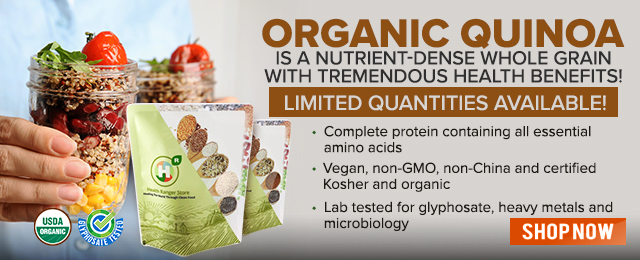
Five Natural Ways to Decrease Your Risk of Developing Type 2 Diabetes
Thursday, October 02, 2008 by: Dr. Ben Kim
Tags: diabetes prevention, health news, Natural News
- Aerosolized bioweapons? Strange “diploid biomasses” falling out of the sky in Florida captured under the microscope
- When antibiotics are unavailable, natural ANTIMICROBIAL compounds become essential first line defenses against infection
- German researchers find link between mRNA vaccines and GENETIC CHANGES that precede CANCER and AUTOIMMUNE DISORDERS
- Exclusive: Microscopic analysis suggests unknown biological contaminants falling from the sky
- DEATH by 12 VACCINES SIMULTANEOUSLY: Doctor playing catch-up on jabs injects 1-year-old baby with massive combination of dirty vax cocktails
- FBI imposed gag order on agents to silence Hunter Biden laptop truth before 2020 election, new chat logs reveal
- Newly released JFK files reveal Pentagon's role in creating Lyme disease and covid in the same lab
- European Court of Justice: Healthcare professionals who promoted or administered COVID-19 vaccines are CRIMINALLY LIABLE for any harm caused
- Nature's liver guardian: Milk thistle's timeless antidote to modern toxin overload
- “Project Aldrin”: Senate probes Meta's alleged censorship dealings with China
- “Bankrupt Tesla” movement EXPOSED: Left-wing extremists, Biden-linked operatives target Elon Musk in coordinated attack
- How the Vaccine Industry escaped accountability for nearly FOUR DECADES, endangering children’s lives for false hopes of protection
- The dark legacy of the U.S. government’s UNETHICAL medical and military research
- NASA, State Dept. admit to renaming DEI programs to dodge Trump's ban in undercover sting
- HAZARDOUS WASTE JABS: Vaccines are classified as “hazardous waste” if dropped on the floor, but as “medicine” when injected into your child
- “The Message of the Sphinx”: Did a lost civilization build the Giza monuments?
- Sleep shortfalls and silent brain decline: How poor sleep patterns may herald Alzheimer's risk
- Astaxanthin: Nature’s ultimate antioxidant powerhouse
- Newly released JFK files reveal Pentagon's role in creating Lyme disease and covid in the same lab
- Oncologist warns of ‘terrifyingly aggressive’ cancers in children, linked to immune suppression from COVID vaccines
- Kiss Your Genetic Privacy Good-Bye! 23andMe Gets Green Light to Sell Your Intimate Genetic Details to Anyone They Want
- European Court of Justice: Healthcare professionals who promoted or administered COVID-19 vaccines are CRIMINALLY LIABLE for any harm caused
- Analysis: The coming economic collapse, a mass uprising and Trump's three secret weapons to halt the growing revolt
- Woman contracts WORLD'S DEADLIEST VIRUS after unknowingly being given the WRONG VACCINE
- Sugar-free deception: Artificial sweeteners hijack hunger signals, fuel obesity epidemic, study warns
- NIH study, buried for decades, reveals that Flu Shots INCREASE elderly deaths, not prevent them
- Britain’s descent into police state censorship: Parents raided for questioning their daughter’s school system online
- AI weather model outperforms traditional forecasts, boosts accuracy by 20%
- Aerosolized bioweapons? Strange “diploid biomasses” falling out of the sky in Florida captured under the microscope
- DARPA: The shadowy innovator behind the world’s most advanced military technologies
- The Health Ranger releases “Vaccine Zombie” song and music video, using AI-animated zombies for the music video
- Utah governor allows ban on LGBT pride flags in public buildings and schools, will take effect without his signature
- COVID-19 scandal linked to CANCER SURGE: Billionaire researcher sounds alarm
- Musk targets “strangely wealthy” lawmakers in DOGE probe, names Pelosi, McConnell, Schumer
- Dr. Suzanne Humphries makes bombshell appearance on Joe Rogan podcast, exposing vaccine industry deception back to POLIOMYELITIS
- Ancient kitchen secrets REVEALED: How garlic, ginger and green onions fight cancer and heart disease
- Newly released JFK files reveal Pentagon's role in creating Lyme disease and covid in the same lab
- California's social media censorship law struck down: A victory for free speech or a threat to online safety?
- EPA advisor admits the agency is funneling billions to climate groups ahead of Trump’s return to White House
- Dr. Mike Yeadon releases 15-minute testimony - WATCH - about genocidal intent of COVID “vaccines”
- The Health Ranger releases “Vaccine Zombie” song and music video, using AI-animated zombies for the music video
- Florida takes a stand: DeSantis proposes permanent ban on mRNA vaccine mandates
- Rep. Nancy Mace introduces bill to ban biological males from female facilities on federal property
- Mike Adams releases country western hit single: Goin’ Back in Time is Comin’ Home
- Sugarcane extract superior to cholesterol-lowering drugs?
- Survival 101: Effective EMF blocking techniques
- “Why we influenced the 2020 elections”: Facebook files reveal the coordinated effort to bury the Hunter Biden laptop story
- Unpacking the Lies That We’ve Been Fed – new song and music video released by Mike Adams, the Health Ranger
- House Intelligence Committee calls for the ARREST and PROSECUTION of Dr. Anthony Fauci
- The pandemic as a tool for INDOCTRINATION: Understanding “The Indoctrinated Brain” by Dr. Michael Nehls
- Mike Adams releases music poetry sensation: A Child of God
- OpenAI whistleblower who dissented against how the company trained ChatGPT found dead
- Attorney and TikTok influencer explains how he was offered hundreds of dollars to make false claims about Trump, Republicans
- CONSERVATIVES SOUND THE ALARM: Big Pharma and the Left trying to force $32 billion money grab from America’s seniors into year-end spending deal
- Red Cross issues warning to stop blood plasma donations from vaccinated people
- Scientists confirm: GENIUS brain function can be spontaneously unleashed in humans without any apparent cause
- EPA advisor admits the agency is funneling billions to climate groups ahead of Trump’s return to White House
- HYSSOP: What research reveals about the health benefits of this ancient holy herb
- Two containers with completed ballots fall out of truck in Florida
- Fully vaccinated about to see “tsunami” of illness and death, warns virologist
- Global leaders unite to clamp down on “misinformation” with UN-backed Cascais Declaration
- BREAKING: 2025 NDAA authorizes mandatory military draft of WOMEN across America… as Pentagon pursues global NUCLEAR war with both Russia and China at the same time
- Michael Yon warns of a ZIONIST TAKEOVER in Trump’s second administration
- Ozempic and Wegovy weight loss drugs are injectable LIZARD VENOM PEPTIDES that may unleash a devastating wave of organ failure… side effects align with symptoms of SNAKE BITES
- BOMBSHELL: DNA testing kits are a SCAM to develop ethnic-specific bioweapons
- Newly released JFK files reveal Pentagon's role in creating Lyme disease and covid in the same lab
- Israeli soldiers accused of even more torture and abuse in the West Bank
- These 13 countries just signed an agreement to engineer a global FAMINE by destroying food supply
- NASA admits that climate change occurs because of changes in Earth’s solar orbit, and NOT because of SUVs and fossil fuels
- The Health Ranger releases “Vaccine Zombie” song and music video, using AI-animated zombies for the music video
- RFK Jr. clears key hurdle: Sen. Susan Collins backs controversial HHS nominee, signaling a new era for health policy
- Sermon 30: How Jesus reveals Caesar’s FAKE CURRENCY and FALSE AUTHORITY
Some of your blood vessels are about as thick as a magic marker, while others are as thin as a strand of hair. All of your blood vessels are essential to your health because they provide the transportation network that allows your blood to carry nutrients and oxygen to each of your cells. Your network of blood vessels also allows your blood to remove waste products from all of your cells.
Diabetes mellitus type 2 (referred to as diabetes throughout the rest of this article) has the potential to be a devastating disease because it slowly clogs up your network of blood vessels, destroying the transportation system that your blood relies entirely upon to nourish and cleanse your cells. Imagine injecting sugar-rich honey or jam into your blood vessels and you have a good idea of why a high blood sugar level is dangerous to your health.
Left unchecked, diabetes can result in complete blockages to your circulatory system, paving the way to every health challenge that we know of, the most common ones being heart disease, neurological disease, vision loss, and sexual dysfunction.
How You Can Develop Diabetes
Whenever you eat sugar or foods that break down into sugar, your blood sugar level rises. Your body senses this rise and makes your pancreas release a hormone called insulin into your blood. Insulin circulates throughout your network of blood vessels along with sugar, and acts as key, opening channels that line your cells, which allows sugar to exit your bloodstream and enter your cells. The net effects of optimal insulin release and function are:
1. Lowering of your blood sugar level.
2. Making sugar available for energy production or storage by your cells.
You can develop diabetes if you regularly eat more sugar and refined carbohydrates than your body can properly use. With repeated intake of sugar and refined carbohydrates, your body is forced to produce and release insulin so frequently that one or both of the following conditions may arise:
1. Your pancreas may not be able to produce enough insulin to effectively deal with your sugar and refined carbohydrate intake.
2. Your cells may become resistant to the effects of insulin.
One or both of these conditions will eventually lead to a high blood sugar level which, over the long term, will dramatically increase your risk of developing blockages in your network of blood vessels.
How to Reduce Your Risk of Developing Diabetes
What follows are the most important steps that you can begin taking today to dramatically reduce your risk of developing diabetes.
1. Regularly engage in some form of exercise that builds and/or maintains your muscle mass. Muscle tissue has significant capacity to store excess blood sugar in the form of glycogen. Simply put, the more muscle you have, the more capacity you have to "soak up" excess blood sugar and maintain a healthy blood sugar level. This is one of the biggest benefits to doing some resistance training on a regular basis.
2. Be active! The more you move your body throughout the day, the more sugar your cells need to burn up to produce energy.
3. Reduce or eliminate your intake of the following most common, sugar-rich foods in today's grocery stores:
* Pop (soda)
* Doughnuts
* Pastries
* Conventional store-bought cookies, cakes, and muffins
* Conventional chocolate/candy bars
* Many boxed breakfast cereals
4. Eat magnesium-rich foods on a regular basis. Studies conducted by researchers from Harvard University and published in the January 2004 issue of the journal Diabetes Care indicate that consistent intake of magnesium-rich foods can significantly lower your risk of developing diabetes.
Healthy magnesium-rich foods include:
* Brown rice
* Raw almonds
* Spinach
* Swiss chard
* Lima beans
* Avocado
* Raw peanuts
* Raw hazelnuts
* Okra
* Black-eyed peas
5. Consider consuming prickly pear cactus, called nopal, in Mexico. Nopal is a natural plant that is grown throughout Mexico and the southwestern United States and has been shown through several studies to be effective at promoting optimal blood sugar levels.
If you follow the measures described above, you can confidently expect to reduce your risk of developing diabetes and improve your overall health.
About the author
Ben Kim is a chiropractor and acupuncturist who lives in Ontario, Canada with his wife and two sons. He provides information on how to experience your best health through natural means at his website, Dr. Ben Kim's Natural Health Website.Dr. Kim is the author of the popular Full Body Cleanse Program
Diabetes prevention at FETCH.news
Get independent news alerts on natural cures, food lab tests, cannabis medicine, science, robotics, drones, privacy and more.
Take Action: Support Natural News by linking to this article from your website
Permalink to this article:
Embed article link: (copy HTML code below):
Reprinting this article:
Non-commercial use OK, cite NaturalNews.com with clickable link.
Follow Natural News on Facebook, Twitter, Google Plus, and Pinterest
Science News & Studies
Medicine News and Information
Food News & Studies
Health News & Studies
Herbs News & Information
Pollution News & Studies
Cancer News & Studies
Climate News & Studies
Survival News & Information
Gear News & Information
News covering technology, stocks, hackers, and more



"Big Tech and mainstream media are constantly trying to silence the independent voices that dare to bring you the truth about toxic food ingredients, dangerous medications and the failed, fraudulent science of the profit-driven medical establishment.
Email is one of the best ways to make sure you stay informed, without the censorship of the tech giants (Google, Apple, Facebook, Twitter, YouTube, etc.). Stay informed and you'll even likely learn information that may help save your own life."
–The Health Ranger, Mike Adams












































